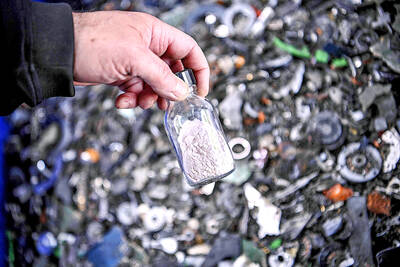The Ministry of Economic Affairs yesterday unveiled the world's first dual-network application services, hoping the innovative application would help Taiwan become a leader in mobile technology. The network also seeks to help communications equipment manufacturers become the nation's third trillion-dollar industry.
"Taiwan is changing its strategy from a follower in the past to a pioneer through integrating new technology and offering new solutions to stimulate new demands," Minister of Economic Affairs Ho Mei-yueh (何美玥) said at a press conference yesterday.
Dual-network integration refers to technology that combines cellular networks with wireless local area networks (WLANs), which means that WLAN and General Packet Radio Service (GPRS) or the third-generation telecom technology can be integrated into one dual-network mobile phone, allowing users to enjoy online services through both mode which complement each other.
The application can provide users with seamless communications through the combined advantages of both a cellular system's rapid switching, wide coverage and WLAN's fast transmission and lower cost.
Cooperating with over 10 information technology and communication service providers, including Acer Inc, Taiwan Cellular Corp (台灣大哥大), and Microsoft Taiwan, the ministry built a model in Taipei City's Nankang Science Park (南港科學園區) to demonstrate the new technology.
The service, for instance, provides workers in the park with various functions, including access to personal e-mails and instant messages or connection to any printer in the park through wireless transmission. Other services allow parents to view their children in the park's daycare center through a surveillance system. The launch of dual-network technology signals the inauguration of the M-Taiwan (mobile-Taiwan) scheme, Ho said, adding that the government plans to spend NT$7 billion to build seamless communication space across the nation in the next three to five years.
The program is expected to boost wireless Internet users to 8 million people and help the nation enter the world's top five in competitiveness of mobile commercial applications, she said.
It would also help propel the nation's communication equipment manufacturing sector to the trillion NT dollar mark by 2008, Ho said.
Taiwan's semiconductor and flat-panel display industries are already worth trillions of NT dollars a year. The nation's communication equipment makers generated production value of NT$463.9 billion last year, up from NT$311.4 billion in 2003, and are estimated to create NT$550 billion-worth of output this year, according to figures provided by the ministry's Industrial Development Bureau.
Betting on the potential of the dual-network technology, Taiwan Cellular is slated to roll out dual-network service packages with a variety of BenQ or Dopod-labeled mobile phones costing around NT$10,000 after the Lunar New Year holiday, said Lancelot Wang (

RECYCLE: Taiwan would aid manufacturers in refining rare earths from discarded appliances, which would fit the nation’s circular economy goals, minister Kung said Taiwan would work with the US and Japan on a proposed cooperation initiative in response to Beijing’s newly announced rare earth export curbs, Minister of Economic Affairs Kung Ming-hsin (龔明鑫) said yesterday. China last week announced new restrictions requiring companies to obtain export licenses if their products contain more than 0.1 percent of Chinese-origin rare earths by value. US Secretary of the Treasury Scott Bessent on Wednesday responded by saying that Beijing was “unreliable” in its rare earths exports, adding that the US would “neither be commanded, nor controlled” by China, several media outlets reported. Japanese Minister of Finance Katsunobu Kato yesterday also

Jensen Huang (黃仁勳), founder and CEO of US-based artificial intelligence chip designer Nvidia Corp and Taiwan Semiconductor Manufacturing Co (TSMC, 台積電) on Friday celebrated the first Nvidia Blackwell wafer produced on US soil. Huang visited TSMC’s advanced wafer fab in the US state of Arizona and joined the Taiwanese chipmaker’s executives to witness the efforts to “build the infrastructure that powers the world’s AI factories, right here in America,” Nvidia said in a statement. At the event, Huang joined Y.L. Wang (王英郎), vice president of operations at TSMC, in signing their names on the Blackwell wafer to

‘DRAMATIC AND POSITIVE’: AI growth would be better than it previously forecast and would stay robust even if the Chinese market became inaccessible for customers, it said Taiwan Semiconductor Manufacturing Co (TSMC, 台積電) yesterday raised its full-year revenue growth outlook after posting record profit for last quarter, despite growing market concern about an artificial intelligence (AI) bubble. The company said it expects revenue to expand about 35 percent year-on-year, driven mainly by faster-than-expected demand for leading-edge chips for AI applications. The world’s biggest contract chipmaker in July projected that revenue this year would expand about 30 percent in US dollar terms. The company also slightly hiked its capital expenditure for this year to US$40 billion to US$42 billion, compared with US$38 billion to US$42 billion it set previously. “AI demand actually

RARE EARTHS: The call between the US Treasury Secretary and his Chinese counterpart came as Washington sought to rally G7 partners in response to China’s export controls China and the US on Saturday agreed to conduct another round of trade negotiations in the coming week, as the world’s two biggest economies seek to avoid another damaging tit-for-tat tariff battle. Beijing last week announced sweeping controls on the critical rare earths industry, prompting US President Donald Trump to threaten 100 percent tariffs on imports from China in retaliation. Trump had also threatened to cancel his expected meeting with Chinese President Xi Jinping (習近平) in South Korea later this month on the sidelines of the APEC summit. In the latest indication of efforts to resolve their dispute, Chinese state media reported that